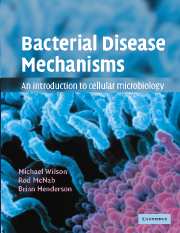Book contents
- Frontmatter
- Contents
- Preface
- Abbreviations used
- Chapter 1 An introduction to bacterial diseases
- Chapter 2 Bacterial cell biology
- Chapter 3 Molecular analysis of bacterial virulence mechanisms
- Chapter 4 Communication in infection
- Chapter 5 The mucosal surface: the front line of antibacterial defence
- Chapter 6 Immune defences against bacteria
- Chapter 7 Bacterial adhesion as a virulence mechanism
- Chapter 8 Bacterial invasion as a virulence mechanism
- Chapter 9 Bacterial exotoxins
- Chapter 10 Bacterial evasion of host defence mechanisms
- Chapter 11 Bacteria in human health and disease: the future?
- Appendix A Glossary of terms used
- Appendix B Brief descriptions of bacteria frequently mentioned
- Index
- Plate section
Chapter 7 - Bacterial adhesion as a virulence mechanism
Published online by Cambridge University Press: 05 June 2012
- Frontmatter
- Contents
- Preface
- Abbreviations used
- Chapter 1 An introduction to bacterial diseases
- Chapter 2 Bacterial cell biology
- Chapter 3 Molecular analysis of bacterial virulence mechanisms
- Chapter 4 Communication in infection
- Chapter 5 The mucosal surface: the front line of antibacterial defence
- Chapter 6 Immune defences against bacteria
- Chapter 7 Bacterial adhesion as a virulence mechanism
- Chapter 8 Bacterial invasion as a virulence mechanism
- Chapter 9 Bacterial exotoxins
- Chapter 10 Bacterial evasion of host defence mechanisms
- Chapter 11 Bacteria in human health and disease: the future?
- Appendix A Glossary of terms used
- Appendix B Brief descriptions of bacteria frequently mentioned
- Index
- Plate section
Summary
Aims
The principal aims of this chapter are to describe:
the molecular basis of bacterial adhesion
the range of adhesins produced by bacteria
the types of bacterial structures involved in adhesion
the nature of the host receptors for bacterial adhesins
tissue tropism
the consequences of adhesion for the bacterium and for the host cell
the possibility of anti-adhesion approaches as prophylactic or therapeutic measures for bacterial infections
Introduction
The ability of a bacterium to adhere to its host is an often-overlooked aspect of virulence and in this chapter we will consider this crucial first stage in the induction of an infectious disease. It is difficult to understand why adhesion should be given such short shrift by many microbiologists as it is an essential preliminary to any interaction (including one of the most intimate interactions possible, disease) between a bacterium and its host. We would also like to stress that adhesion should not be regarded simply as a somewhat random, serendipitous ‘sticking’ of a bacterium to its host. Rather, the adhesion process is accomplished by highly specific molecular interactions and is accompanied by changes in the phenotype of the bacterium and, when the substratum is cellular, changes in the behaviour of the host cell.
Before we go any further, it is important to consider how we should go about investigating the interactions between bacteria and host cells. Practical bacteriology is traditionally based on the use of a ‘pure culture’ (axenic) of an organism.
- Type
- Chapter
- Information
- Bacterial Disease MechanismsAn Introduction to Cellular Microbiology, pp. 353 - 404Publisher: Cambridge University PressPrint publication year: 2002
- 2
- Cited by



